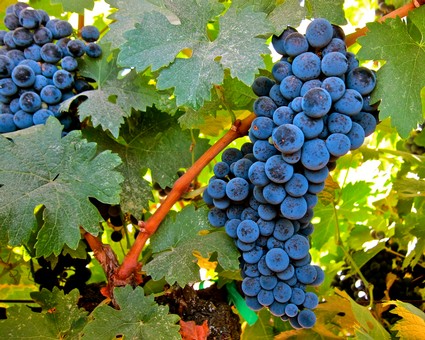Letters from Lodi
An insightful and objective look at viticulture and winemaking from the Lodi
Appellation and the growers and vintners behind these crafts. Told from the
perspective of multi-award winning wine journalist, Randy Caparoso.
The 100 (plus!) grapes of Lodi
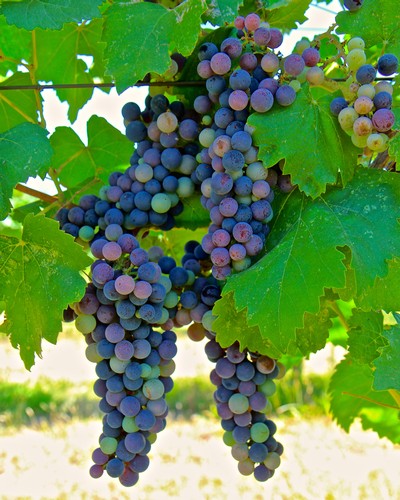
July colors of Blauer Affenthaler, a very old yet rare German grape, planted in Lodi's Mokelumne Glen Vineyards
If anything, the Lodi Viticultural Area is prolific. We now count 126 grape varieties planted in the region; all variations of Vitis vinifera, belonging to the original European family or species of wine grapes.
Why Lodi? Simply put, this is where the California wine industry sources most of the grapes going into wines sold for $10 and under, which is about 74% of all the wine sold in the U.S. (re our recent report on the 2017 Wine Economics Symposium).
Needless to say, Lodi also furnishes a huge percentage of grapes going into premium priced (anything above $10) California wines. The wide variety of specialty wine grapes cultivated by Lodi growers such as Bokisch Ranches, Ripken Vineyards, Mohr-Fry Ranches or Silvaspoons Vineyards supply both giant producers (such as E. & J. Gallo, Constellation Brands or Trinchero Family Estates) and the tiniest boutique wineries (Forlorn Hope, The Scholium Project, Odisea/Cochon, Loma Prieta, Michael Klouda, etc.), and wineries of all sizes in between (Bonny Doon Vineyards, Neyers, Michael David, Jeff Runquist, et al.).
And with ever-proliferating consumer tastes, there is growing demand for grapes like Verdelho and Vermentino, Piquepoul and Pinotage, Graciano and Grenache, from Alicante Bouschet to Zweigelt, Nero d’Avola to Montepulciano, and so forth.
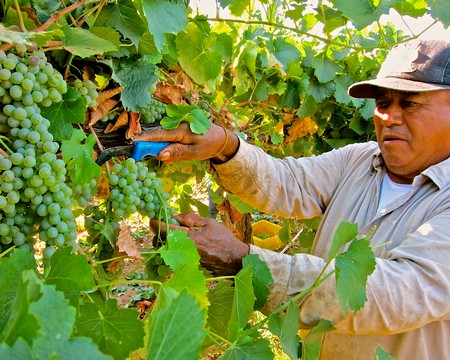
Verdelho harvest in Lodi's Silvaspoons Vineyards
Another reason why there are so many wine grapes grown in the Delta: Because Lodi can. The region’s classic, moderate Mediterranean climate is naturally conducive to wine grapes. The cultivation of Vitis vinifera, after all, originated in the Mediterranean Basin – in the vicinity of present-day Iran, Palestine and Egypt as long ago as 5,000 years ago, and was first perfected around 2,500 years ago in Greece and the ancient Roman Empire.
Lodi also possesses the classic soil types for high quality viticulture – consistently deep (as much as 50 feet), porous yet fertile sandy loam around the City of Lodi (distinguished as the Mokelumne River AVA), and gravelly or cobbly clay loams on slopes east and north of the city (Lodi’s Jahant, Clements Hills, Borden Ranch, Alta Mesa, Cosumnes River and Sloughhouse Viticultural Areas).
Lodi is not unique, of course, in respect to climate and soils highly amenable to multiple grapes. You could say the same about Mendocino, Lake County, Santa Cruz Mountains, Monterey, Santa Barbara, San Luis Obispo, as well as Napa Valley and Sonoma County. 50 years ago, there was a full range of grapes grown in Napa Valley – Chenin Blanc, Colombard, Riesling, Gray Riesling (a.k.a. Trousseau Gris), Charbono, Carignan, Napa Gamay (a.k.a. Valdiquié), Grignolino, Green Hungarian, you name it – but what has obviously changed is the economics of grape growing in coastal areas. Even if vintners wanted to grow Green Hungarian or Grignolino in places like Napa Valley or Santa Cruz Mountains, costs and market realities make growing anything other than Cabernet Sauvignon, Merlot, Pinot Noir or Chardonnay less and less feasible with each passing year.
If you’re into variety, thank goodness for a place like Lodi!
Bastardo (a.k.a. Trousseau Noir) in Ripken Vineyards
So let us count our grapes. But first, some explanation, since delineation of grape varieties is not so straightforward as you may think.
As grape scientists may point out, there are several significant “families” of wine grapes that may be identical in terms of DNA. For instance, as in most regions in California and Oregon, there are multiple clones of Pinot Noir grown in Lodi – variations of this ancient black skinned grape that might have slightly different grape or leaf morphology, may bud out and ripen at different times, and produce wines with varying aromas and phenolic content. Nonetheless, on our list we count all Pinot Noir cultivars as one and the same grape.
There are, however, other variations of the Pinot grape possessing the exact same DNA sequence, but which are obviously different in terms of even wider variance of plant morphology and subsequent wine types. Therefore, grapes such as Pinot Gris (a.k.a. Pinot Grigio), Pinot Blanc and Pinot Meunier are counted as separate varieties.
Then it gets tricky. Primitivo, for instance, is a black skinned grape with DNA identical to Zinfandel. Primitivo is so similar to Zinfandel that, frankly, many California growers sell their Primitivo to wineries as Zinfandel. Still, the U.S. Department of Treasury's TTB, which regulates use of varietal names on wine labels, counts Primitivo as a separate variety; and therefore Primitivo is listed as a separate grape on our list.
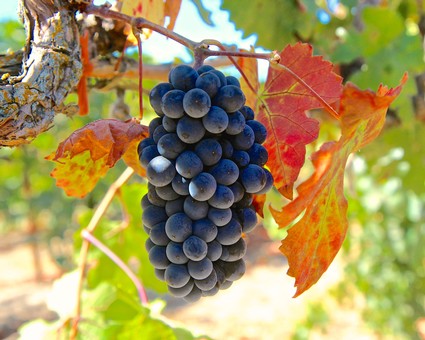
Mettler Family Vineyards Pinotage; a pungent cross of Pinot Noir and Cinsaut, originating in South Africa
As it were, the TTB is not always an up-to-date arbiter of grape identification. As of this writing, Torrontés, Mencía and Marzemino are examples of grapes not even listed by the TTB, despite their obvious existence and usage elsewhere in the world. There is also one grape on our list – F1-16, a black skinned cross developed by Stanislaus County botanist Fay Triplett in the 1960s – that does not even have a name, just a U.C. Davis Foundation Plant Services number (although Ripken Vineyards’ Rip Ripken has nicknamed it “Rip’s Black” for its rich color and notable acidity). But since these grapes exist in Lodi fields, they are counted on our list.
For the large part, we lump together clonal variations of grapes such as Pinot Noir, Tempranillo, Chardonnay, Cabernet Sauvignon, Riesling, Grenache, Syrah, etc. all as one grape, respectively. But we make further exceptions when sensory qualities in resulting wines are so distinct, standard industry practice is to count clonal variants separately. Sauvignon Musqué, for example, is a Sauvignon Blanc; but its floral aroma is so different from most Sauvignon Blancs, both growers and wineries identify the grape as unique unto itself. The same for other fragrant varieties such as Muscat, with its "Canelli," “Orange” and “Giallo” (“Yellow”) variants, among others.
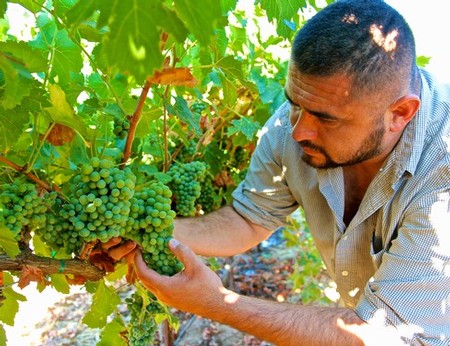
Bokisch Ranches Vineyard Manager Alex Lopez looking at ripening 2017 Verdejo in their Clay Station Vineyard
That said, our list, along with selected images plus notations regarding common synonyms and specific grape crosses:
Albalonga - Riesling x Silvaner
Albariño (a.k.a. Alvarinho)
Alicante Bouschet – Petit Bouschet (Teinturier du Cher x Aramon) x Grenache
Alvarinho (a.k.a. Albariño)
Arnsburger – Riesling Clones 88 x 64
Bacchus – Silvaner x Riesling
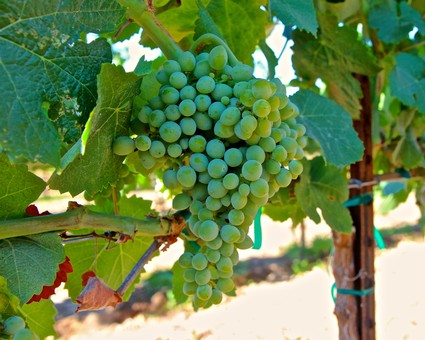
Bourboulenc; a rare Southern French grape cultivated by Lodi's Acquiesce Winery
Bastardo (a.k.a. Trousseau Noir)
Black Prince (a.k.a. Rose of Peru)
Blaufränkisch (a.k.a. Lemberger; Blauer Limberger; Blue Franc)
Cabernet Dorsa – Dornfelder (Helfensteiner {Frühburgunder x Trollinger} x Heroldrebe {Blaire Portugieser x Blaufränkisch}) x Cabernet Sauvignon
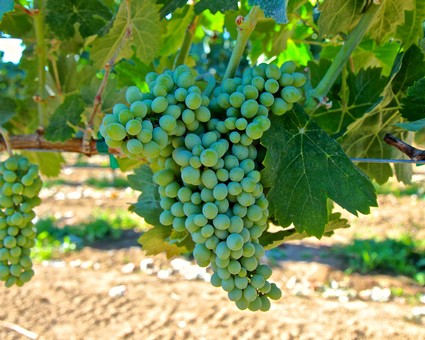
Clairette Blanche; another classic Southern French grape grown by Acquiesce Winery
Cabernet Franc (a.k.a. Bouchet)
Cabernet Sauvignon
Carignan (a.k.a. Carignane; Cariñena)
Carménère (a.k.a. Grande Vidure)
Carmine – (Cabernet Sauvignon x Carignan) x Merlot;
Charbono (a.k.a. Douce Noir; Bonarda; Corbeau)
Chardonnay
Chenin Blanc (a.k.a. Pineau de la Loire)
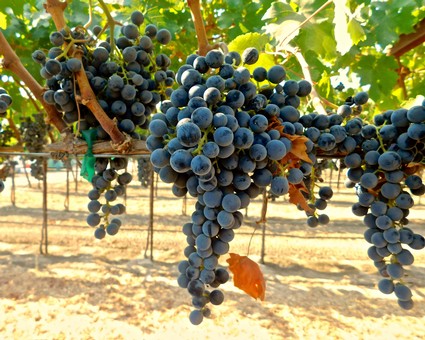
Carmènére; the near-forgotten (in California) fifth red wine grape of Bordeaux, grown by Phillips Farms (for Michael David Winery)
Cinsaut (a.k.a. Cinsault; Black Malvoisie)
Colombard (a.k.a. French Colombard)
Domina - Blauer Portugieser x Pinot Noir
Dornfelder –Helfensteiner (Frühburgunder x Trollinger) x Heroldrebe (Blauer Portugieser x Blaufränkisch)
Ehrenfelser - Riesling x Silvaner
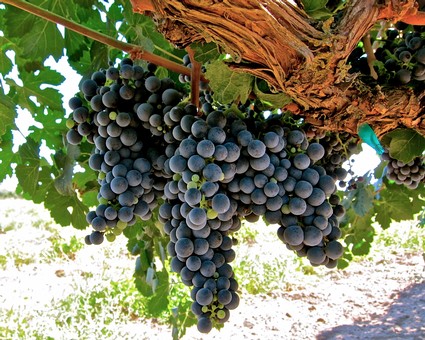
Dolcetto; a deep colored, sprightly Northern Italian grape grown in Lodi by both Ripken Vineyards (pictured here) and Celle Vineyard (for Klinkker Brick Winery)
F1-16 (a.k.a. Rip’s Black) – T213-13 (61-9 {Grenache x Gros Manzanc} x 74-21A {Zinfandel x Cabernet Sauvignon}) x T42-36 (Ruby Cabernet {Cabernet Sauvignon x Carignan} x Barbera)
Faberrebe - Pinot Blanc x Müller-Thurgau (Riesling x Madeleine Royale)
Forta - Silvaner x Madeleine Angevine (Madeleine Royale x Précoce de Malingre)
Frühburgunder (a.k.a. Pinot Noir Précoce)
Garnacha (a.k.a. Grenache Noir; Cannonau)
Grand Noir (a.k.a. Grand Noir de la Calmette)
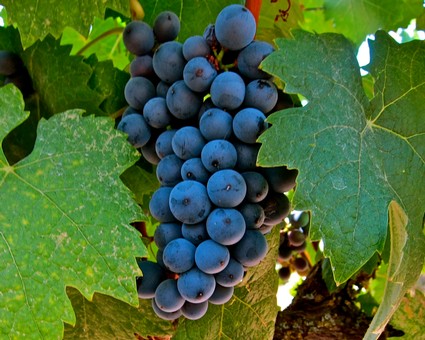
Bokisch Ranches' Terra Alta Vineyard Graciano; a Spanish grape that grows amazingly well in Lodi
Graciano
Grenache Noir (a.k.a. Garnacha; Cannonau)
Grenache Blanc (a.k.a. Garnacha Blanca)
Grignolino
Gutedel (a.k.a. Chasselas; Fendant)
Huxelrebe – Gutedel (a.k.a. Chasselas) x Courtiller Musqué (a.k.a. Muscat Précoce de Saumur)
Kanzler - Müller-Thurgau (Riesling x Madeleine Royale) x Silvaner
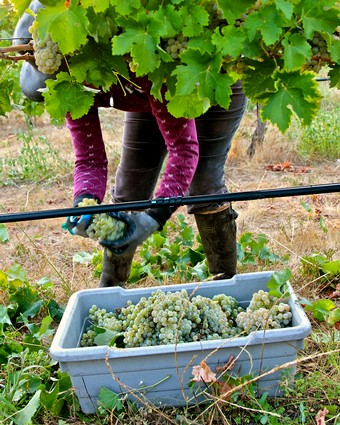
Kerner harvest in Lodi's Mokelumne Glen Vineyards
Kerner - Trollinger x Riesling
Macabeo (a.k.a. Viura)
Malbec (a.k.a. Auxerrois)
Merlot
Mission (a.k.a. Listan Prieto)
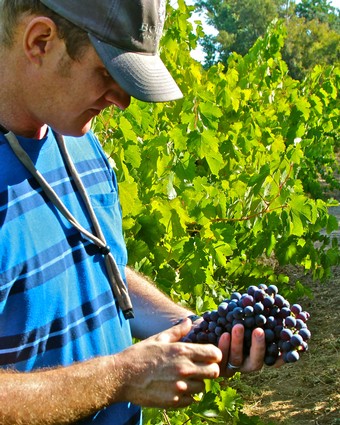
Eric Pooler, Director of Winegrowering for Boisset Family Estates, looking at Mission; a heritage grape grown in Lodi by Mike Anagnos' Sunwest Ag Service
Morio Muscat - Silvaner x Pinot Blanc
Moscato Giallo (a.k.a. Yellow Muscat)
Mourvèdre (a.k.a. Mataro; Monastrell)
Müller-Thurgau - Riesling x Madeleine Royale
Muscat Canelli (a.k.a. Muscat Blanc; Muscat Blanc à Petits Grains)
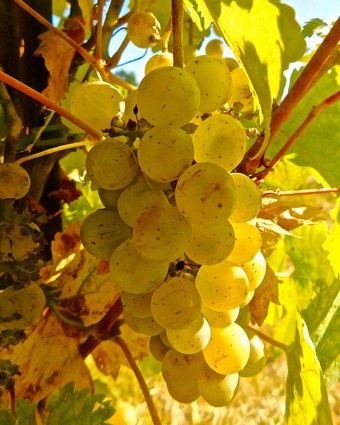
Ortega; a German crossing grown by Mokelumne Glen Vineyards
Nero d’Avola
Noblessa - Madeleine Angevine (Circe x Madeleine Royale) x Silvaner
Optima - (Riesling x Silvaner) x Müller-Thurgau (Riesling x Madeleine Royale)
Oraniensteiner - Riesling x Silvaner
Ortega – Müller-Thurgau (Riesling x Madeleine Royale) x Siegerrebe (Madeleine Angevine {Madeleine Royale x Précoce de Malingre} x Gewürztraminer)
Perle - Gewürztraminer x Müller-Thurgau (Riesling x Madeleine Royale)
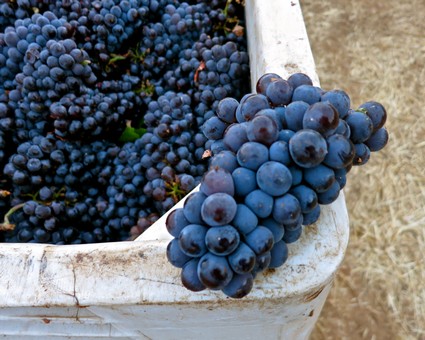
Just-picked Pinot Noir in Bokisch Ranches' Terra Alta Vineyard
Petite Sirah (a.k.a. Durif) - Syrah x Peloursin
Phoenix – Bacchus ({Silvaner x Riesling} x Müller-Thurgau {Riesling x Madeleine Royale}) x Villard Blanc (Le Subereaux x Siebel 6468)
Pinot Blanc (a.k.a. Weissburgunder; Klevner)
Pinot Gris (a.k.a. Pinot Grigio; Grauburgunder; Ruländer)
Pinot Meunier (a.k.a. Schwarzriesling)
Pinot Noir (a.k.a. Spätburgunder; Blauburgunder)
Pinotage - Pinot Noir x Cinsaut
Piquepoul (a.k.a. Picpoul Blanc)

A grape called Phoenix; another exotic German crossing grown by Lodi's Mokelumne Glen Vineyards
Primitivo (a.k.a. Zinfandel)
Prinzipal – Geisenheim 323 58 x Ehrenfelser (Riesling x Silvaner)
Regent - (Silvaner x Müller-Thurgau) x Chambourcin (unknown Seibel based hybrid)
Rieslaner - (Silvaner x Riesling)
Riesling
Rondo – Zarya Severa (Vitis amurensis x Malingre Précoce) x St. Laurent
Rotberger - Trollinger x Riesling
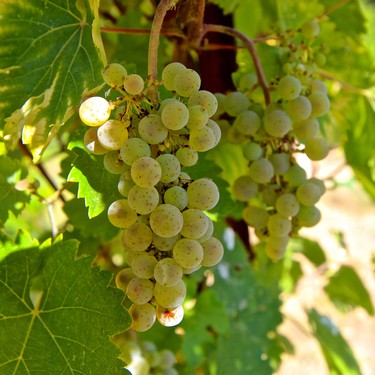
The rare Prinzipal; a German crossing cultivated by Mokelumne Glen Vineyards
Roter Traminer (a.k.a. Savagnin Rose)
Roter Veltliner (a.k.a. Roter Muskateller)
Sauvignon Blanc (a.k.a. Fumé Blanc)
Sauvignon Musqué (a.k.a. Sauvignon Blanc)
Scheurebe - Riesling x unknown
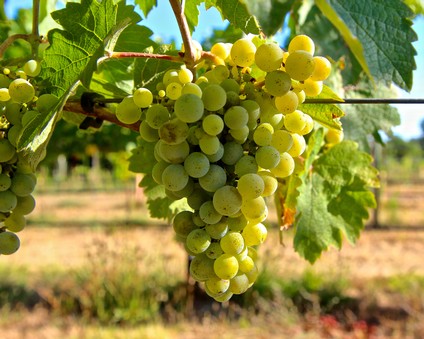
Mokelumne Glen Vineyards Rotgipfler, a white wine grape rarely seen outside of its native Austria
Schönburger - Pinot Noir x (Chasselas x Muscat Hamburg)
Siegerrebe - Madeleine Angevine (Madeleine Royale x Précoce de Malingre) x Gewürztraminer
Silvaner (a.k.a. Sylvaner)
Sirius - Bacchus ([Silvaner x Riesling] x Müller-Thurgau [Riesling x Madeleine Royale]) x Seyve Villard 12-375
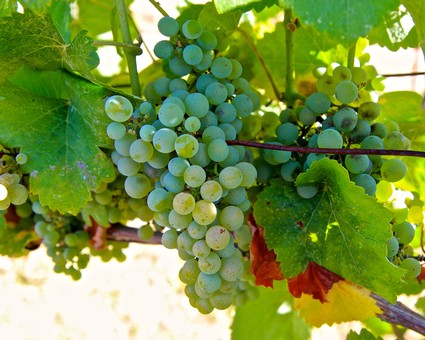
Råuschling grape: a cultivar of German and Swiss origins, planted in Lodi's Mokelumne Glen Vineyards
Sultana (a.k.a. Thompson Seedless)
Symphony - Muscat of Alexandria x Grenache Gris
Syrah (a.k.a. Shiraz)
Tempranillo (a.k.a. Tinta Roriz; Tinta de Toro; Tinta Fino; Valdepeñas)
Tokay (a.k.a. Flame Tokay; Ahmer Bou'Amer)
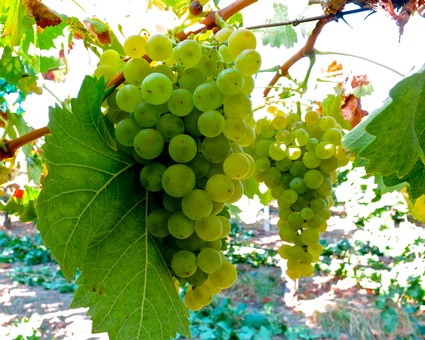
Silvaspoons Vineyards Torrontés, grown in Lodi's Alta Mesa AVA
Torrontés
Traminer (a.k.a. Savagnin)
Trincadeira Preta (a.k.a. Tinta Amarela)
Trollinger (a.k.a. Schiava)
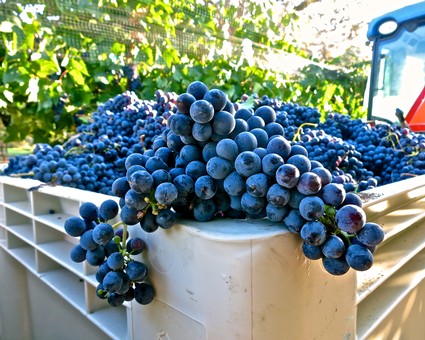
Sangiovese harvest in Lodi's Sorelle Vineyard
Verdelho
Vermentino (a.k.a. Rolle; Pigato; Favorita)
Würzer - Gewürztraminer x Müller-Thurgau (Riesling x Madeleine Royale)
Zinfandel
Zweigelt
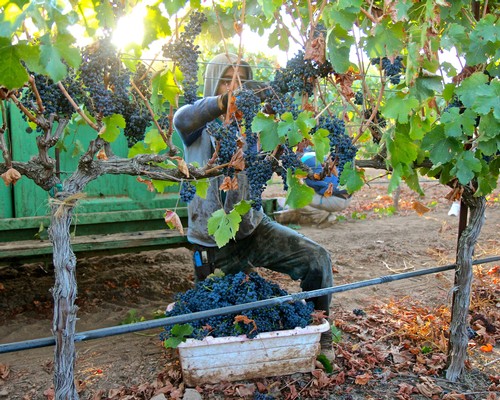
Phillips Farms Petite Sirah harvest (for Michael David Winery)
